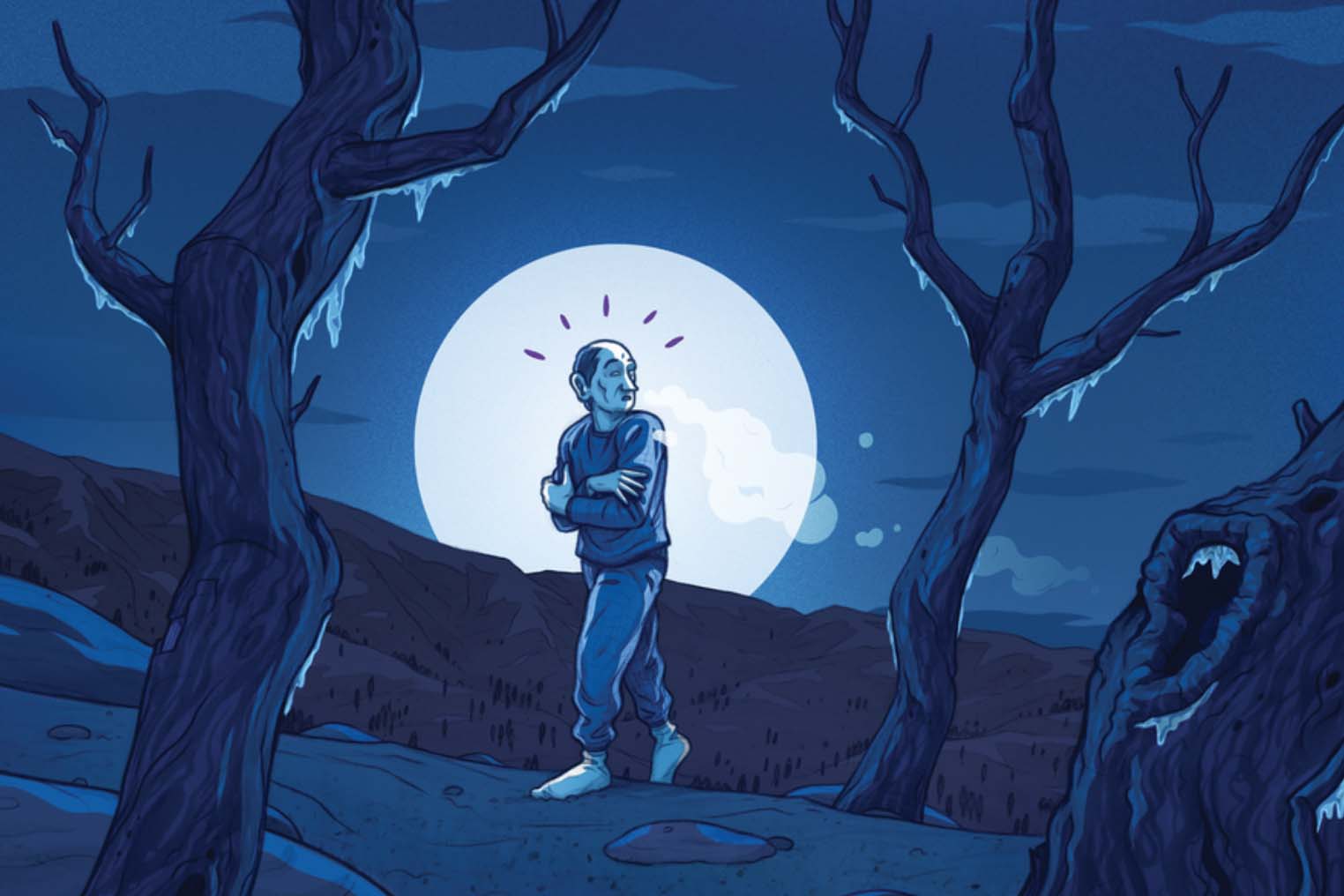Sleepwalking Into the Wilderness

Sleepwalker (Photo: Max Temescu)
My eyes fluttered open. The last thing I remembered was crawling into my sleeping bag, but now I was standing upright, surrounded by dark forest. Without my contacts, everything was shadows and blurs. I was in a sleepy trance, unsure of where I was or how I got there. I squinted at the thicket of black trees and made out a ridge ahead. Something in my foggy, half-asleep brain thought it had the answers. Right! I’m going up the hill to those houses to call for help.
I started forward, but my foot collided with a log and I tumbled face-first into a creek. My entire body plunged into the freezing water. I gasped and scrambled out on the other side. Stumbling to my feet and now fully awake, I realized there weren’t any houses up on the ridge. There was nothing but wilderness for miles. The icy water had yanked me out of my stupor—I was alone, and I was in trouble.
I hadn’t sleepwalked in over 50 years, so it was the last thing on my mind when I made my way out to the Frank Church-River of No Return Wilderness. I scouted a campsite for my annual trip with my son, settling on a spot near a low-traffic dirt road in the wide valley below Pinyon Peak. The next day, I met my son, Jordan, at a nearby road junction. We drove to camp, drank a beer, and tucked in for the night. I climbed into the tent in my long johns, wool socks, long-sleeve cotton shirt, and a light thermal layer. Next thing I knew, I was standing in the dark dripping cold creek water.
I pulled my arms inside my shirt and hugged myself for warmth. My sleeves stuck straight out, frozen solid. It was October in central Idaho at 8,000 feet, and it was about 20°F out. Without shoes, my feet were cold and tender. The pain distracted me from the fear that I would freeze to death.
Unsure how far I’d wandered or in what direction, it seemed fruitless to try and retrace my steps. Instead, I’d head downhill, find a road, and orient myself from there. Minutes later, I emerged on a dirt road. I didn’t know if it was the one we had camped along, much less where it led, but I picked a direction and walked a few hundred yards. Seeing no sign of camp, I turned and walked back the other way for about a mile. Still nothing. I reversed again—maybe I hadn’t gone far enough in the original direction. I was soaking wet, freezing, and starting to panic, but the adrenaline kept me focused. All I could think about was finding camp.
I walked a few miles until the road went over a ridge. We’d camped at the bottom of a similar feature, but I still didn’t recognize anything. Keep moving, I told myself. If this was the right road, there would be a highway turnoff 8.5 miles downhill and, hopefully, cars. Hiking there would produce body heat and help keep my mind occupied. It would take seven or eight hours to reach the turnoff—it would be light out by then. I gritted my teeth and focused on the thought of that warm morning sun on the horizon.
My icy clothes clung to my skin and the frigid air stung. Rocks stabbed my arches and I cursed loudly with each step. My increasingly raw feet helped distract me from the idea that I might not make it. I kept moving and hoped that I had chosen the right direction. I thought about it like running a marathon: I just had to keep slogging to the finish line.
After a few hours, well past midnight, the moon finally emerged above the treetops, confirming that I was walking southwest, in what I thought was the right direction.
With moonlight came hallucinations. I imagined more houses ahead of me, but as I got closer I would see that they were just stands of pine. I saw a herd of elk crossing the road, but knew it wasn’t real when I heard no snorting or stomping hooves. I considered the idea that I was having a vivid dream, and any minute I would wake up in my sleeping bag. But that was just the cold muddling my thoughts. I picked up the pace.
After about five hours of stumbling down the road, the sky lightened to reveal meadows in the distance. Exhilarated, I realized I was a few miles from the turnoff. Once I hit the highway, there would surely be traffic. I wanted to get off my feet and back to my son as soon as possible.
As I finally approached the turnoff, I noticed a camper at the far end of a meadow. I saw movement, but without my contacts I couldn’t be sure it was people. As I limped closer, three men emerged, and they all stared at me. I couldn’t blame them—what a spectacle I must have been in my long johns and socks in the wintry weather, my sleeves frozen and sticking out like a scarecrow’s arms. One of the men greeted me, and I explained everything. They were shocked, but happy to drive me back to camp.
I was overjoyed to reunite with Jordan, who had been out searching for me all morning. He took one look at my purple feet and insisted I see a doctor. We loaded into the truck and, sighing with relief, I turned the heat up high.